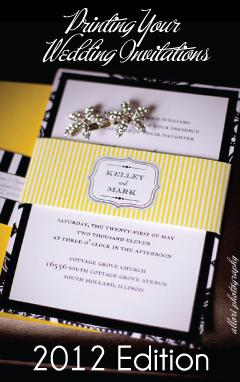
Around this time, circa 2010, I highlighted the current “season within the wedding season” that most brides have found themselves in -- printing the invitations. I explored basic distinctions between solid and process colors, cover and text weight stocks.
Its 2012, and I'd like to re-introduce readers to our “mini-glossary” of printing terms. After this installment, you will be well on your way to discussing your invitations with your stationer or printer.
DIFFERENT PRINTING METHODS
There are multiple printing methods available to you that you should consider before actually sending your invitations to press.
Lithography (LE THA GRAFEE) or Offset Printing
This method of printing is one of the most popular. It involves burning the image or artwork to four separate plates, a cyan plate, a magenta plate, a yellow plate and a black plate. Some presses have enough stations to accommodate solid ink plates as well. Stock is fed through the press and the image is transferred or “offset” onto a blanket from the plate and from the blanket to the stock.
Pros: Ink coverage is of a superior quality. Great for achieving consistency on creative that has solid blocks of color.
Cons: Setup costs are expensive and will be your main cost driver. Typical invitation quantities of 150 to 300 are usually considered too small for Lithography printing, unless solid colors are absolutely necessary. Contract proofs (which I recommend for accurately reviewing color) also add to your costs and are on average $75 and up.
Digital Printing
Extremely popular printing method for a short run! Digital presses usually use toner-based inks and do not require plates. The setup costs for digital quality prints are low and you essentially pay for stock used + ink.
Pros: Perfect for qtys ranging from 25 – 500. Invitation and other wedding stationery elements typically fall right into this category. Proof costs are minimal and can be output as a “one off” from the press onto the stock you have selected.
Cons: Ink coverage and quality is not as nice and rich as lithography, and solid colors cannot be achieved through the digital printing process. CMYK only!
Engraving
Engraving is without a doubt, the most expensive method of printing your invite. Text and images are etched onto a copper plate, and your stock “kisses” the plate. The area where the image and text are become raised. The test for true engraving is to check the back of the stock. You will see an actual indentation on the back of the stock from the plate.
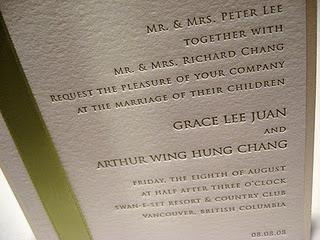
dolcepress.com
Pros: You can be confident that you are using the most traditional method of printing your invitations. Engraving will provide the highest quality.
Cons: Invitation costs will skyrocket. Budget conscious brides will find this method to be cost prohibitive.
Thermography (THUR MAH GRAFEE) Printing
Beautiful after execution, thermography printing also features lettering that is RAISED. The process occurs on press and involves spreading thermal powders on the wet ink and heating it. The area that has been treated with the powder dries into a solid mass, hence, the dimension.
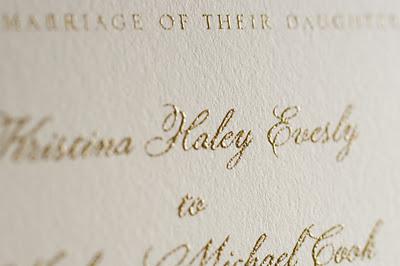
blog.tinyprints.com
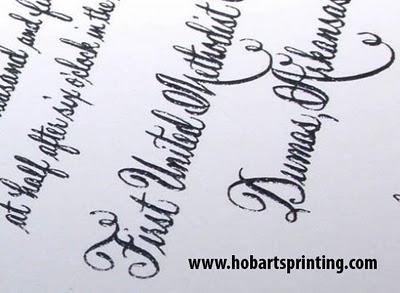
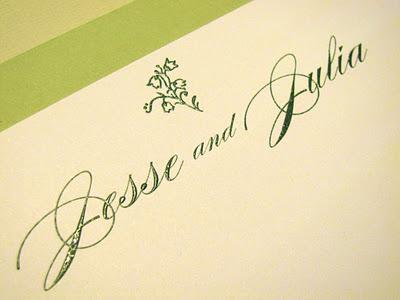
theletteredset.com
Pros: Often referred to as the “poor mans engraving”, this method is cheaper than engraving and gives your invitations an “all too important” feel and look!
Cons: Because the raised lettering effect occurs on press, there is no way to REALLY inspect the proof prior to the press run. A small intangible, but I like to show my clients everything!
Letterpress
The opposite effect of engraving and thermography is letterpress. It is relief printing. Steel backed plates with raised metal type are pressed into thick, high-quality stock. The result is usually a beautiful motif and type indentation that is filled with ink. Read tips from Accucolor Printing on what works and what doesn’t when designing for letterpress. Also, check out a video of a letterpress machine in action! The machines are dinosaurs, but in fact it was a popular method of printing for over 500 years!
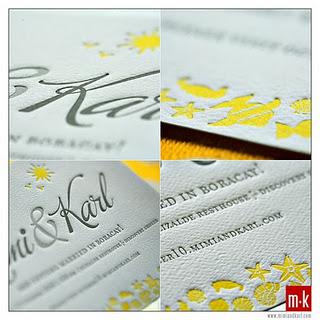
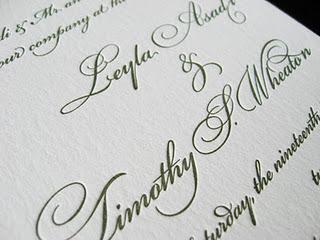
plushinvitations.squarespace.com
Pros: There are so many beautiful combinations of letterforms and artwork that can be effective for letterpress printing; I believe the bride that elects this method will end up with the most tactile invitation that guests are sure to interact with.
Cons: Costs… Design and printing of letterpress can be very costly, especially if your quantity is over 100.
Finally, these are some miscellaneous red flags that you should keep in mind. You may need to raise these questions with your printer/stationer based on the nature of your invite:
- If there needs to be heavy ink coverage on your invitation, ask about the finish... Will it be shiny or will have an uncoated look? If you don't want a shiny finish, then ask if any kind of coating can be used to achieve the finish that you want...
- Should there be a concern about ink ruboff on envelopes if working with blacks or dark navy?
- What is the best printing method based on the design that you have chosen?
- Is a physical proof of your invitation materials on the stock that you've selected available prior to printing? If so, is there a cost for this?
- Are there recycled stock/paper options for your invitation?
- Are there discounts available for placing an order for everything up front (i.e. thank you cards, menus, etc.)?
These questions will remind the vendors involved that you have done your research and you DO know what you are talking about!
Take care and congrats to all the NEWLY engaged out there. Flash that ring and enjoy!!!


